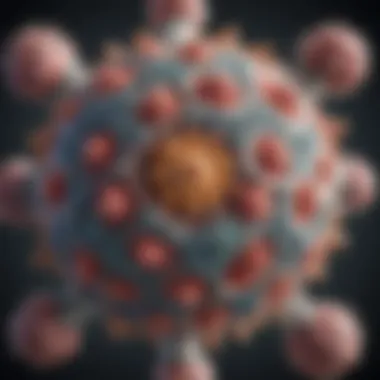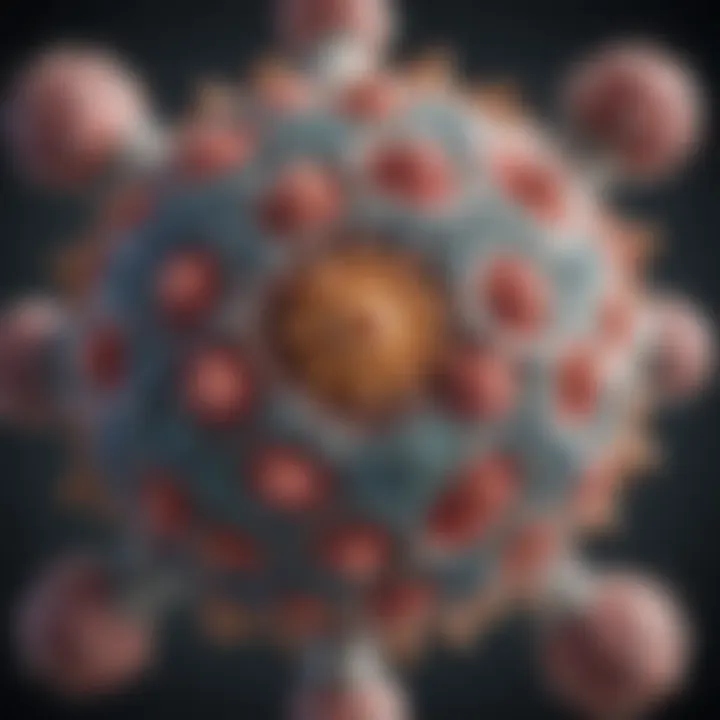Understanding Asymptomatic HPV: Biology and Implications


Intro
Human papillomavirus (HPV) is a complex virus that can present significant challenges in both diagnosis and management, particularly when the individual is asymptomatic. Asymptomatic HPV cases can complicate public health efforts due to their stealthy nature. While many types of HPV can cause visible symptoms such as warts or lesions, a considerable number do not manifest any physical signs. This lack of symptoms can delay diagnosis, leaving many individuals unaware of their infection status.
In this article, we will explore the biological mechanisms driving asymptomatic presentations of HPV, discuss their prevalence, and assess the implications for clinical practice. We will also highlight screening practices and preventative measures that can help mitigate risks associated with asymptomatic HPV infections. By bridging the gap between scientific research and practical understanding, this discussion aims to cater to both medical professionals and those seeking to enhance their knowledge on this important subject.
Recent Advances
Recent research has significantly advanced our understanding of HPV, particularly in recognizing and addressing asymptomatic cases.
Latest Discoveries
Recent studies have revealed that asymptomatic HPV infections are more common than previously understood. For instance, a study published in the Journal of Infectious Diseases highlighted the fact that up to 90% of HPV infections can clear naturally within two years. However, some can persist and lead to cancers later in life, which presents a dual challenge for health professionals and educators alike.
Furthermore, advancements in molecular diagnostic techniques, such as polymerase chain reaction (PCR) and next-generation sequencing, have improved our ability to detect low viral loads, thus revealing asymptomatic infections that might have gone unnoticed.
Technological Innovations
Technological innovations are playing an essential role in managing HPVs asymptomatic presentations. Enhanced screening methods, like the use of HPV DNA testing alongside traditional Pap smears, are increasing the detection rates of HPV types associated with high oncogenic risk. These methods not only improve diagnostic accuracy but also help in tailoring preventive strategies for at-risk populations.
"The integration of advanced technological approaches in the screening process underscores the synergy between research and clinical practice."
Methodology
A thorough understanding of how HPV research is conducted reveals valuable insights into the virus's asymptomatic nature.
Research Design
Most contemporary research on HPV employs observational epidemiological designs. These studies are designed to capture data on both symptomatic and asymptomatic populations, aiming to identify patterns of prevalence and transmission. By including diverse demographic groups, researchers can gain a broader understanding of how HPV behaves in various contexts.
Data Collection Techniques
Data collection for HPV studies often includes a blend of quantitative and qualitative methodologies. Surveys and medical records review are common practices to gather information on HPV status, risk factors, and screening outcomes. Furthermore, biobanking samples collected from individuals for testing can enhance the data quality and allow for ongoing longitudinal studies that monitor HPV's long-term impacts, especially in asymptomatic cases.
By focusing on current methodologies and advances, we can better understand how to approach the asymptomatic nature of HPV effectively. This knowledge ultimately contributes to the broader goal of enhancing public health initiatives aimed at prevention and education.
Intro to HPV
Human Papillomavirus (HPV) stands as one of the most common sexually transmitted infections globally. Understanding this virus is crucial not only for health professionals but also for students, researchers, and educators. The implications of HPV extend far beyond individual health; they encompass public health considerations, the effectiveness of prevention strategies, and the management of asymptomatic cases.
The significance of HPV cannot be overstated. In some individuals, the infection is asymptomatic, which contributes to its spread and presents challenges in diagnosis. By elucidating the nature of HPV, its types, and its characteristics, healthcare providers can better inform patients regarding risks and preventive measures. Improved knowledge also aids in developing better screening and intervention strategies.
Definition and Overview
HPV refers to a group of more than 200 related viruses, some of which can cause health problems including genital warts and various cancers. HPV is classified into low-risk and high-risk types. Low-risk types can cause warts, whereas high-risk types are associated with cancers, particularly cervical cancer. HPV is primarily transmitted through intimate skin-to-skin contact.
The majority of HPV infections resolve spontaneously without causing any symptoms or health issues. However, persistent infection with high-risk HPV can lead to the development of anogenital cancers and oropharyngeal cancers. This potential for serious outcomes underscores the importance of ongoing research and education surrounding HPV.
Types of HPV
HPV is categorized into several types based on their risk levels:
- Low-Risk HPV Types: These include HPV 6 and HPV 11, which are commonly associated with genital warts and are not linked to cancer.
- High-Risk HPV Types: This group includes HPV 16 and HPV 18, known for their association with cervical cancer and other anogenital cancers.
- Other Types: There are numerous other types classified as intermediates, each with varying potential for causing disease.
Understanding these categories is essential for both individual and public health. Recognizing the types can assist in tailoring prevention strategies such as vaccination, which is effective against the most common high-risk strains. Public awareness and education around these types are integral in managing the burden of HPV infection in populations.


Understanding Asymptomatic HPV
Understanding asymptomatic HPV is a crucial component of comprehending the broader implications of human papillomavirus infections. Asymptomatic cases pose unique challenges for individuals and healthcare systems. Without visible symptoms, many may remain unaware of their HPV status, thereby increasing the risk of transmission and developing potential long-term health outcomes.
By exploring asymptomatic presentations, one can identify key elements of viral behavior, screening practices, and the importance of preventive measures. It sheds light on the potential public health consequences, as these silent infections could contribute to a higher prevalence of HPV-related diseases.
What Does Asymptomatic Mean?
The term "asymptomatic" refers to the absence of noticeable symptoms, despite the presence of the virus in the body. This means individuals can be infected with HPV without exhibiting signs such as warts or cervical dysplasia. This lack of symptoms can lead to a false sense of security, causing individuals to delay medical consultations and screenings.
As a result, asymptomatic carriers may unknowingly propagate the virus, thus complicating public health efforts aimed at controlling HPV transmission. Understanding the definition of asymptomatic HPV is vital for raising awareness and encouraging proactive health behaviors within populations.
Prevalence of Asymptomatic Cases
Research indicates that a significant proportion of HPV infections are asymptomatic. Data show that approximately 70% of those infected will not exhibit any symptoms. This high prevalence complicates efforts to control the virus and provides insights into its transmission dynamics.
Several studies have indicated varying prevalence rates based on population subgroups. For instance, sexually active individuals under the age of 25 are often at a higher risk of being asymptomatic carriers. Factors contributing to this prevalence include behavioral patterns, sexual history, and individual immune responses.
- High prevalence among younger populations
- Varying rates across ethnic and geographic groups
- The influence of sexual behaviors on transmission rates
Why Some Individuals Remain Asymptomatic
The reasons behind individuals remaining asymptomatic while infected with HPV are complex and not entirely understood. Key factors can be considered:
- Immune Response: The immune system plays a major role in controlling and suppressing HPV. Some individuals may have a stronger immune response, allowing them to manage the virus without developing symptoms.
- Viral Strain Variation: Different strains of HPV can behave differently in the host. Low-risk types may result in fewer symptoms and thus go unnoticed more frequently.
- Host Factors: Individual genetic predispositions and overall health may contribute to the presence or absence of symptoms during an HPV infection.
- Delayed Onset of Symptoms: Often, symptoms may take years to develop, leading to long periods without awareness of the infection.
Understanding these factors is essential for developing effective screening and treatment strategies, emphasizing the need for continued research in the field of HPV.
The Biology of HPV Infection
Understanding the biology of HPV infection is vital to comprehending its asymptomatic nature and the challenges it presents. The virus operates through complex mechanisms that influence how it interacts with the host's cellular environment. By exploring the viral life cycle and immune response, we can better appreciate the overarching implications of HPV asymptomatic presentations.
Viral Life Cycle
The life cycle of HPV begins when the virus enters the epithelial cells of the host. It uses micro-abrasions or other means to penetrate the skin or mucous membrane. Once inside, the virus must establish itself by inducing the host's cells to replicate the viral DNA. This process occurs primarily in the basal layer of the epithelium.
- Entry: HPV attaches to specific receptors on host cells, which facilitates its entry.
- Dissemination: The viral DNA is transported to the nucleus of the host cell. This step is crucial as it allows the virus to exploit the host's cellular machinery for its replication.
- Gene Expression: The viral DNA utilizes the host's transcription and translation processes to produce viral proteins. These proteins are essential for new viral particles and help in manipulating the host cell's functions.
- Replication: Newly formed viral genomes replicate alongside the cell's DNA. This step is what allows the virus to persist, especially in asymptomatic carriers.
- Release: Finally, the mature viral particles exit the cell, often destroying the host cell in the process. This release enables subsequent cycles of infection as the virus spreads to adjacent cells.
Understanding this cycle is crucial. It explains why many individuals do not exhibit symptoms despite being infected. The ability for the virus to lie dormant makes traditional screening methods less effective in asymptomatic cases.
Immune Response to HPV
The immune response to HPV is a complex interplay between viral factors and host defenses. Most individuals carry the HPV without showing any health issues because of a healthy immune reaction. However, some important points about the immune response are:
- Initial Response: After infection, the immune system's innate response comes into play. Phagocytes and dendritic cells recognize viral particles and start the recruitment of T-cells and B-cells.
- Cell-mediated Immunity: T-cells play a prominent role in clearing the virus. They recognize infected cells and induce apoptosis, limiting the virus's ability to replicate.
- Antibody Production: B-cells produce antibodies against HPV, although this response may not be sufficient to prevent re-infection or limit asymptomatic persistence.
- Latency: HPV has a unique strategy to evade the immune system. It can establish a latent infection, allowing it to escape detection. This persistence complicates clearance and increases the risk of future complications like cervical cancer.
In summary, exploring the biology of HPV infection highlights not only how the virus thrives but also why it can remain undetected. An understanding of its life cycle and immune evasion mechanisms is essential for developing effective prevention and management strategies.
Diagnosis Challenges
Understanding the diagnosis challenges surrounding HPV, especially in asymptomatic cases, is crucial for effective public health management. Many individuals infected with HPV do not present any visible symptoms, making detection challenging. This lack of symptoms can lead to prolonged periods of undiagnosed infection, increasing the risk of transmission and potential complications, such as cervical cancer. The subtlety of asymptomatic presentations complicates routine medical practices and could result in missed opportunities for early intervention.
Routine Screening Limitations
Routine screening for HPV, primarily through Pap tests and HPV DNA tests, has its limitations. These tests are designed to detect abnormal changes in cervical cells that may indicate the presence of the virus. However, there are several factors that hinder their effectiveness in asymptomatic individuals:
- Interval Timing: Screening guidelines often recommend Pap tests every three years for those aged 21 to 29 and every five years for those aged 30 to 65 who also have HPV tests. Due to these intervals, individuals may go years without being screened, allowing potential infections to persist undetected.
- False Negatives: Standard screening tests can sometimes yield false-negative results. This means that a person may be infected with HPV but receive a negative test result, leading to a false sense of security.
- Limited Demographics: Many screening programs target specific age groups, which may overlook younger or older individuals who also could be at risk of asymptomatic HPV without regular screenings.


These limitations must be recognized to improve strategies for early detection and intervention.
Role of HPV Testing
HPV testing plays an essential role in diagnosing asymptomatic cases. Unlike routine screening methods targeted solely at detecting cervical changes, HPV testing identifies the presence of the virus itself. This capability allows for a more proactive approach in managing HPV infections. Key points regarding the role of HPV testing include:
- Identification of High-Risk Strains: HPV testing can differentiate between high-risk and low-risk strains of the virus. This distinction is vital in understanding potential progression to cervical cancer, as it facilitates targeted monitoring and management plans.
- Informing Screening Decisions: The integration of HPV testing with routine Pap tests can enhance the accuracy of cervical cancer screening. For example, if a person tests positive for high-risk HPV, their healthcare provider may recommend more frequent screenings or further examinations to monitor for cervical changes.
- Public Health Impact: As HPV testing becomes more widely utilized, it can enhance public health measures by identifying carriers of the virus who may not exhibit symptoms. This identification is important for tracing and informing sexual partners about potential exposure, thus contributing to a more informed and healthier community.
"The effectiveness of HPV testing goes beyond individual health, impacting community health initiatives and cervical cancer prevention strategies."
Risk Factors Associated with Asymptomatic HPV
Understanding the risk factors related to asymptomatic HPV is crucial for comprehensive public health strategies. HPV infection can occur in individuals without any symptoms, leading to complications, especially if the virus progresses undetected. Identifying these risk factors can improve screening and prevention efforts. Here is a detailed look into behavioral factors and genetic predisposition.
Behavioral Factors
Behavioral factors are significant contributors to the risk of being asymptomatic with HPV. Certain activities and lifestyle choices can influence the likelihood of infection without noticeable symptoms. Some notable considerations include:
- Sexual Activity: Increased numbers of sexual partners can elevate the risk of contracting HPV. Those who engage in unprotected sex are also at higher risk.
- Age: Adolescents and young adults are typically more susceptible to HPV, partly due to changes in sexual behavior and biology at this stage.
- Smoking: Tobacco use is linked to a weakened immune system. This can affect the body's ability to combat HPV infections.
- Health Status: Individuals with pre-existing conditions, particularly those affecting the immune system, may be more likely to harbor HPV asymptomatically.
Regular sexual health education can help demystify aspects of HPV and advocate for safer sexual practices. Additionally, public health campaigns emphasizing the importance of routine screenings can mitigate the risks associated with these behavioral factors by ensuring early intervention.
Genetic Predisposition
Genetic predisposition plays a role in the body's response to HPV infection. This aspect can influence whether an individual develops any symptoms or harbors the virus asymptomatically. Key elements to consider include:
- Family History: A family history of HPV-related diseases, such as cervical cancer, may suggest a heightened genetic vulnerability to these infections.
- Genetic Variants: Specific genetic markers may exist that can influence how efficiently the immune system responds to HPV. Understanding these genetic variants is still under research.
- Ethnicity: Some studies suggest that certain ethnic groups may experience differing prevalence rates of HPV and associated diseases due to genetic and environmental factors.
Research into the genetic factors of HPV continues to evolve. Awareness of individual genetic risks can lead to more personalized healthcare plans and preventive measures. Testing for specific genetic markers might become part of the regular screening process in the future, improving detection of HPV in asymptomatic individuals.
"Understanding these risk factors can dramatically shift how healthcare providers approach HPV testing and prevention."
In summary, the interplay between behavioral and genetic factors greatly affects the prevalence and management of asymptomatic HPV. Recognizing these elements enables a more nuanced understanding of HPV's impact on public health, guiding better strategies for education, screening, and intervention.
Potential Consequences of Asymptomatic HPV
Asymptomatic presentations of human papillomavirus (HPV) are often overlooked, yet they carry significant consequences that affect individuals and public health at large. Understanding these consequences is critical for recognizing the importance of monitoring and managing HPV infections, especially since many individuals may not be aware that they are carriers of the virus.
Link to Cervical Cancer
Recent studies indicate that persistent infection with certain high-risk HPV types is strongly linked to the development of cervical cancer. Notably, HPV 16 and HPV 18 are responsible for a substantial proportion of cases. The lack of symptoms leads many to underestimate their risk, and this can delay necessary screening and treatment.
- High-risk HPV types can integrate into the host cell's genome, potentially disrupting normal cellular functions.
- The transition from HPV infection to cervical cancer can be a lengthy process, often spanning years, and during this time, the individual might remain asymptomatic.
- This risk highlights the importance of regular cervical screenings like Pap smears and HPV testing, even for those who feel healthy.
"Asymptomatic HPV cases present a unique challenge for early detection of cervical cancer, increasing the urgency for educational outreach on screening benefits."
Impact on Public Health Statistics
The prevalence of asymptomatic HPV can significantly impact public health statistics. In many communities, the number of diagnosed cases does not represent the true infection rate due to asymptomatic carriers. This discrepancy can lead to underestimations of the HPV burden, affecting resource allocation and health policy decisions.
- As asymptomatic individuals contribute to the virus’s transmission unknowingly, control efforts become difficult.
- Comprehensive data collection must account for these silent infections to create effective prevention strategies.
- Public health campaigns need to emphasize the importance of awareness, destigmatizing HPV and encouraging individuals to seek regular testing, regardless of symptoms.
Addressing the potential consequences of asymptomatic HPV is essential in creating informed communities and improving public health outcomes. It underscores the necessity for ongoing research and the implementation of targeted health strategies.
Preventative Measures


Preventative measures are crucial in reducing the incidence of HPV-related diseases, particularly in asymptomatic cases. These measures not only help to contain the spread of the virus but also enhance overall public health outcomes. Understanding the specifics of these measures can significantly impact individual choices and health policies.
Vaccination Protocols
Vaccination plays a vital role in preventing HPV infections. The vaccines, such as Gardasil and Cervarix, target high-risk HPV types associated with cervical cancer. These vaccines are most effective when administered before the onset of sexual activity, ideally during early adolescence. Here are some important points regarding vaccination protocols:
- Recommended Age: It is advisable for preteens, typically at age 11 or 12, to receive the vaccine. This is important because it ensures individuals are protected before exposure to the virus.
- Catch-Up Vaccination: Vaccination is also encouraged up to age 26 for those who were not adequately vaccinated earlier.
- Types of Vaccines: There are vaccines that cover two, four, or nine HPV types. Each variant has its effectiveness against various HPV strains.
- Dosing Schedule: A two or three-dose schedule is typically recommended, depending on the age at first vaccination.
The availability and promotion of these vaccines can drastically change HPV prevalence rates, especially in populations with lower vaccination coverage.
Public Awareness Campaigns
The effectiveness of prevention strategies is largely influenced by public awareness. Campaigns aimed at educating individuals about HPV, its transmission, and the existence of vaccines can empower communities. Here are several components to consider:
- Educational Materials: Distributing brochures and digital content that explain HPV facts and myths can demystify the virus and encourage proactive health decisions.
- Social Media Engagement: Utilizing platforms like Facebook and Reddit for awareness campaigns can reach diverse groups. Posting testimonials and expert talks can normalize discussions about HPV and sexual health.
- Community Programs: Collaborating with local health organizations to host seminars or workshops can directly address community needs, promote vaccination, and provide screening information.
- Targeting At-Risk Populations: Some campaigns may need to focus on specific demographics known to have higher rates of HPV infections. Tailoring messaging for these groups can maximize outreach.
"Educating the public about HPV and its consequences is the first step towards significant changes in prevention and treatment outcomes."
Effective public awareness not only fosters a sense of community responsibility but also encourages individuals to seek out vaccinations and regular screenings. Addressing HPV through comprehensive preventative measures is essential for better health outcomes.
Management Strategies
Effective management of asymptomatic HPV cases is critical. It involves a thorough understanding of individual patient needs and the nuances of the virus itself. Effective strategies can lead to early detection, treatment, and potentially, a reduction in the transmission of HPV.
Monitoring Asymptomatic Individuals
Monitoring asymptomatic individuals is vital for several reasons. First, asymptomatic carriers of HPV can still transmit the virus to sexual partners, creating a cycle of infection. Regular monitoring helps in identifying these individuals before they can pass the virus to others. Furthermore, long-term follow-up can ensure early detection of any potential complications associated with HPV, such as dysplasia or cervical cancer.
Some strategies for monitoring can include:
- Regular screenings: Despite being asymptomatic, routine Pap smears and HPV tests can help in early identification of any changes in cervical cells.
- Patient education: Educating individuals on the importance of regular check-ups is essential. Knowledge empowers them to seek help promptly.
- Utilization of technology: Mobile applications and telemedicine services can offer reminders for screenings, thus improving compliance among patients who may otherwise neglect their health.
Clinical Guidelines for Healthcare Providers
Clinical guidelines for healthcare providers regarding asymptomatic HPV cases need to balance patient care with public health considerations. These guidelines usually include recommendations on screening intervals, follow-up protocols, and patient communication techniques. Healthcare professionals should be trained to recognize the unique risks posed by asymptomatic individuals and prioritize their management accordingly.
Recommended clinical guidelines can include:
- Screening Frequency: Follow established guidelines such as those from the American College of Obstetricians and Gynecologists, recommending Pap smears starting at age 21, regardless of sexual history.
- Risk Assessments: Conducting thorough assessments of a patient's sexual history, immune status, and other risk factors to tailor monitoring strategies effectively.
- Patient Engagement: Communicating openly with patients about their HPV status, management strategies, and the risk of transmission is crucial. An engaged patient is more likely to adhere to recommended practices.
Research Trends in HPV Asymptomatic Cases
Understanding the trends in research focused on HPV asymptomatic presentations is vital for several reasons. Asymptomatic infections complicate the public health approach to HPV management. They increase the risk of transmission without the infected individuals being aware of their status. Thus, current studies are directing more attention towards identifying these silent carriers. Research trends highlight how scientists are working to uncover the biological mechanisms behind asymptomatic cases and their epidemiological implications.
The significance of this research is further underscored by the pressing need to improve screening techniques. As traditional screening methods often miss those who are asymptomatic, investigations focus on alternative diagnostic tools that can identify these cases more effectively. Moreover, research efforts aim to understand the long-term consequences of living with asymptomatic HPV, bridging gaps in existing knowledge while addressing various health systems issues.
Recent Findings
Recent studies have demonstrated a notable correlation between specific HPV genotypes and asymptomatic presentations. For instance, HPV type 16 and 18, which are associated with high-risk cervical cancers, often go undetected in individuals who exhibit no visible symptoms. Furthermore, research has suggested that the immune system plays a critical role in controlling these infections. Factors such as age, gender, and genetic predisposition have shown variations in immune responses. This understanding can help in crafting better preventative measures, including tailored vaccination strategies.
Additionally, important data has emerged regarding the effectiveness of current screening methods. Research indicates that many asymptomatic cases were first identified through enhanced screening protocols, underscoring a need for continued innovation in diagnostic technologies.
Future Directions in Research
Future research into HPV asymptomatic cases should prioritize several areas of inquiry. One significant direction is the longitudinal study of asymptomatic individuals to understand the natural history of HPV infections better. This includes monitoring the progression from asymptomatic states to symptomatic manifestations over several years.
Furthermore, advancing diagnostic techniques remains a pivotal focus. Researchers are exploring molecular testing methods that could detect viral presence even in the absence of symptoms. This may include the use of liquid biopsy or advanced imaging technology.
Lastly, there is a growing interest in understanding the psychosocial impact of being diagnosed with HPV. Developing effective counseling methods for patients who may feel isolated or concerned about stigma can greatly enhance public health initiatives.
"The exploration of HPV asymptomatic cases not only impacts individual health outcomes but also shapes community health strategies and policies."
In summary, the intersection of recent findings and future research directions in HPV asymptomatic cases holds the potential to transform our understanding of the virus and its implications across various demographics. This knowledge could lead to improved diagnostic tools, better management strategies, and ultimately, a reduction in HPV transmission rates.















